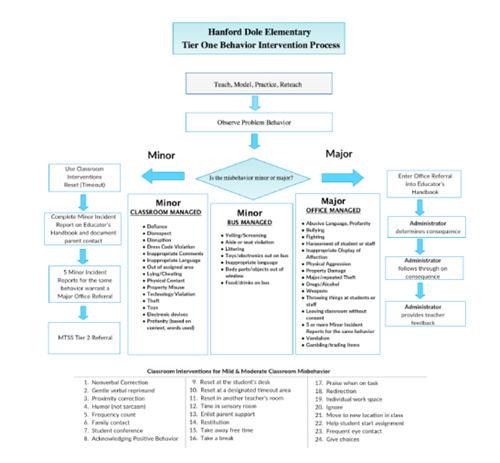- Hanford Dole Elementary School
- STUDENT & PARENT HANDBOOK
-

Click here for a PDF version of the Student/Parent Handbook or use the drop down tabs to read specific areas.
HANFORD-DOLE ELEMENTARY SCHOOL PARENT HANDBOOK
-
SCHOOL CONTACT INFORMATION
465 Choate Road
Salisbury, NC 28146(704)639-3046 (office)
(704)603-6886 (fax) -
VISION AND MISSION
Mission Statement:
To provide and sustain a safe school environment that promotes many opportunities for discovery and learning.Vision:
Nurturing, preparing, and empowering lifelong learners to explore the possibilities and responsibilities of their future.RSS Core Values
● Include
● Honor
● Innovate
● Execute
● ServeWe have Bobcat PRIDE
Polite
Respect
Involved
Determined
Excellent -
SCHOOL HOURS AND PROCEDURES
School Hours -- 7:30 am-2:30 pm (*Tardy bell will ring at 7:30 am)
Office Hours -- 7:00 am-3:45 pm
Morning/Afternoon Procedures
-
● Students may arrive at 7:10 am, and enter through the cafeteria or front door. No student will be admitted prior to 7:10 am, as there will be no adult supervision.
● Students who arrive after the 7:30 am tardy bell must be accompanied to the school office by a parent/guardian for admittance into the school.
● Students will not be dismissed from classrooms for checkout after 2:00 pm (no exceptions). All afternoon, early checkouts must occur prior to 2:00 pm. Students checking out of school early without presentation of a valid medical appointment card will be issued a tardy.
● In order to change your child’s afternoon transportation, a parent/guardian must send a signed note to their child’s teacher or through ClassDojo on the morning of the change. Phone calls for transportation changes will only be accepted in case of an emergency. No phone transportation changes will be made after 2:00 pm. In no circumstance will we be able to accept a student’s voiced change of transportation.
-
-
ATTENDANCE AND TARDY
North Carolina law requires school attendance for school-aged children. When a child is absent from school the absence will be recorded as “lawful” or “unlawful.” A written note must be sent to the teacher following your child’s absence. Children cannot stay in school if they have a fever of 100 degrees or above, nausea, vomiting, diarrhea or any undiagnosed rash. If a child leaves school for a fever of 100 degrees they will be asked to not return the student to school until they have been fever free for up to 24 hours. Please refer to the Rowan-Salisbury Schools Student Code of Conduct Manual for additional information.
Tardy Policy
- A parent/gardian must accompany and sign in student at front office after 7:30AM tardy bell and for any early dismissal.
- Students arriving past 7:30AM and/or checking out of school before 2:30PM will be counted as tardy.
Late Arrivals
When students arrive at school late, this disrupts their class and decreases their opportunity for instructional time. Students are considered to be tardy if they are not in their assigned classroom at the 7:30 am bell. Students that ride the school bus will not be considered tardy if the bus arrives after the start of school. If your child is late to school, an adult must sign the student in at the main office. Please do not drop your child off in front of the school alone after 7:30 am.
Early Dismissals
There will be no student dismissal 30 minutes before the end of the day (between 2:00 and 2:30) unless approved, in advance, by the Principal. If possible, please schedule appointments outside of this window. This procedure was implemented at all elementary schools beginning August 2017, to better ensure student safety during dismissal time. If you are picking up your child within the early dismissal window, please wait in the designated area outside of the office until your child is dismissed. Please help us maximize instructional time by keeping early dismissals to a minimum throughout the school year. -
VISITOR POLICY
● All visitors must ring the doorbell, show ID and report to the front office to sign in
● Parents are permitted to eat lunch with their child(ren). Parents must first sign in at the office and receive a visitor’s pass.
● In order for a family member to eat with your child, their name must be listed on the Student Emergency Information Sheet/card kept in the front office.
● All parents/visitors are to sit in the assigned areas in the cafeteria when eating lunch with their child.
-
BIRTHDAYS
We know that birthday celebrations are important and we welcome the opportunity for you to celebrate your child’s special day at school. In order to make sure that we maximize the school day, all birthday celebrations will be held during lunch (unless otherwise stated). Parents are welcome to bring a store bought light snacks for classmates to celebrate with such as cupcakes and juice.
Please be sure to contact your child’s teacher ahead of time to make arrangements.
-
BREAKFAST & LUNCH PROCEDURES
Breakfast Procedures
● Breakfast is provided for every student at Hanford Dole ES.
● Students are expected to eat lunch in their classrooms and arrive with their breakfast. Students may not be allowed back in the cafeteria if they leave without breakfast.
Lunch Procedures
-
Please have your identification ready to scan for entry.
● Please meet with your child in the cafeteria area. Do not go to the classroom to meet.
● Please sit in the designated areas for parent/child lunch times.
● When lunch is complete, please return to the Main Office to drop off your ID badge and check out
● We ask that you do not linger after lunch as this interferes with instructional time.
● No balloons will be permitted on the premises, as well as “party decorations".
-
-
PARENT CONTACT INFORMATION
- In case of emergency, please make sure the front office and your child’s teacher have a current working number.
- Please make address changes through the front office with our Data Manager
-
UNIFORM POLICY/BACKPACKS
Uniforms
The school uniform policy is approved by the RSS Board of Education and is strictly implemented at Hanford-Dole Elementary School. In the event a student reports to school out of uniform, the parent/guardian will be notified by the child’s teacher to bring the appropriate uniform clothing to school as soon as possible. The Hanford Dole Elementary uniform policy is:
- Any solid color, collared knitted polo shirt with short or long sleeves with no logos
- Any solid color sweatshirt (no hoods)
- On Fridays, students will be permitted to wear their PTA-sponsored Hanford Dole Elementary shirts.
- All bottoms must be either black, navy blue or khaki, no jeans will be allowed.
- Girls may wear skirts or dresses that are knee-length
- Students must wear only closed-toe, rubber sole shoes
- Solid colored socks and tights that are white, navy blue, or black may be worn
Backpacks
Children should have a backpack labeled with (his/her name in permanent marker inside) large letters. It will be placed in an assigned area and will not be accessible during the day. The backpack will be used to transport finished work and other school items back and forth on a daily basis. Please make sure the backpack can carry the child’s work, a lunch box (optional) and a large library book. A bag that is too small is difficult for a child to pack and increases the chance of notes/work being lost. Please check your child's backpack on a daily basis.
-
CELL PHONE USE
Cell phones are not allowed in school. If a student is found in possession of a cell phone, a behavior matrix will be followed and will be confiscated by the administration.
-
DISCIPLINE POLICY
PBIS
Hanford Dole adopted Positive Behavioral Interventions and Supports (PBIS) as its method for supporting students with behaviors in the school environment. Through PBIS, the school staff creates school-wide expectations for behavior throughout the common areas of the school building. Throughout the school, there is signage that indicates the expectations per our motto of PRIDE for the bathroom, hallway, but, etc. All students are expected to follow the school wide rules of PRIDE, Be Polite, Be Respectful, Be Involved, Be Determined and Be Excellent. Students will review these expectations and rules with their teachers during the first week of school and on a quarterly basis with the administrative team. Teachers are expected to utilize a common language with all students and promote encouragement to students and/or whole classes that are demonstrating positive behaviors that align with PRIDE. Positive Behavioral Interventions and Supports (PBIS) is based on a problem-solving model and aims to prevent inappropriate behavior through teaching and reinforcing appropriate behaviors (OSEP Technical Assistance Center on Positive Behavioral Interventions & Supports, 2007). Positive Behavioral Interventions and Supports (PBIS) is a process that is consistent with the core principles of MTSS. PBIS offers a range of interventions that are systematically applied to students based on their demonstrated level of need, and addresses the role of the environment as it applies to development and improvement of behavior problems (https://www.pbis.org/school/mtss). (from PBIS Newsletter Vol 4, Issue 2)
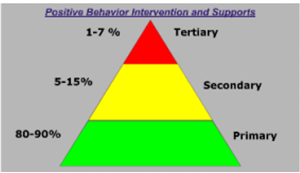
Tear 1 - School-Wide for all Students
Class Dojo
This is a school-wide way to track positive behaviors and communicate with parents on a regular basis.
School-Wide Attention Signal -
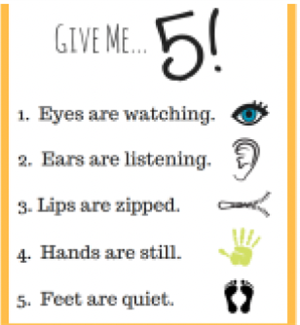
PRIDE Paws - These are provided by Administration to each teacher. All teachers are to give them to students as they witness positive behaviors of being: polite, respectful, involved, determined, and excellent (e.g. when a student is demonstrating manners, working hard, or making good choices). Please try to give each student at least one at some point during a week with those students making positive choices consistently receiving more. Students are to place the PRIDE Paws in one of the buckets (Pk-2nd or 3rd-5th) located outside of the Media Center. A drawing will be held at the end of each quarter during an assembly where approximately 30-40 prizes will be given out.
Whole-Class Recognition (Sticker Chart) - Any staff member who notices a class making positive choices can give that class a paw print sticker (provided by Administration). When a class fills up their chart (provided by Administration) they get a reward which is provided by the teacher. The class can vote at the beginning to decide on a reward they are working towards.
PBIS Monthly Incentives - Students who meet certain criteria (e.g. no office/bus referrals, a certain amount of Dojo Points) will be invited to a celebration.
“Pawsitive” Office Referrals - Teachers and students can fill these out for someone they notice being kind/helpful to others. Students will bring the office referrals to an administrator for recognition.
Bus and Car Rider Students of the Month - Bus Drivers and teachers who have car rider duty, can elect certain students who are demonstrating positive behavior. They will be recognized at the end of the month.
Good Citizens of the Month - Teachers will nominate a student by the 25th of each month who has demonstrated the Character Trait of that month.
Character Traits:
Good Citizen Character Trait of the month Nomination Spreadsheet (add a name by the end of each month)
School-Wide Positive Behavior Expectations- These should be posted in each classroom and individual posters are located in each area of the building they relate to. Classroom Rules/Expectations should also align with PRIDE and be: Be Polite, Be Respectful, Be Involved, Be Determined, and Be Excellent. Remind, model, and reteach these expectations throughout the year.
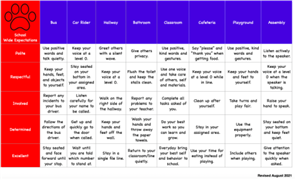
Zones of Regulation
Each Grade utilizes the Zones of Regulation Check-In each morning to keep track of where their students are in terms of RTL, or Readiness to Learn. Each Zone corresponds to how students are feeling emotionally and assists in helping themselves and helping the teacher to regulate student behavior.
QR Codes to be posted in classrooms for each individual grade level are here: QR Codes for ZoR
PBIS Lessons
Teach
1. Go to the particular area of the building that you will be discussing the expectations for.
2. Overview of the lesson: “Today we are going to talk about how we can show PRIDE in the ___________________.
3. Show students the location of the matrix for that area of the building.
4. Discuss the details of the expectations with students.
Model
1. Demonstrate examples of NOT following expectations.
2. Choose a couple of students to show examples of following the expectations.
3. Discussion. “Tell me what PRIDE looks like in the ______________.”
Practice
1. Have all students practice following the expectations for that particular area of the school.
2. Debrief with students any questions. “Are there any questions you have about showing PRIDE in the ________________?”
The Bobcat Den (Sensory Room) - This room can be used in all tiers of PBIS. Students can come individually with a staff member or the room can be reserved for a class or group. When coming individually they can set the time based on the expectations of the staff member and choose their activity. When the timer goes off it is the expectation that they return to class ready to learn.
Behavior Incident Flow Chart - click here
If a student receives an office referral, the student will receive the appropriate disciplinary action from the following matrix. An administrator reserves the right adjust as needed on an individual basis.
Tier 2
Students who need extra support in addition to Tier 1 Interventions and Supports. This is data-driven, according to the Educator Handbook or Class Dojo. Teachers who need additional support with certain students need to schedule an appointment with the Individual Problem Solving Team (IPST) - MTSS. Interventions need to be completed with fidelity.
Tier 3
A student who has been in Tier 2, but is showing little to no progress, will then begin a more intensive intervention. IPST will meet and assist the teacher with this process. This is also data-driven and interventions need to be completed with fidelity.
-
BEHAVIOR/DISCIPLINE MATRIX
This discipline matrix will be utilized by HDES administrators to handle major office referrals through Educator’s Handbook. This will allow equity and timely/appropriate response to student behaviors that could impact learning within classrooms.
Level 1:
Level 1 Behaviors: These are behaviors that are minor incidents that have continually repeated in the classroom and have now resulted in a major referral.
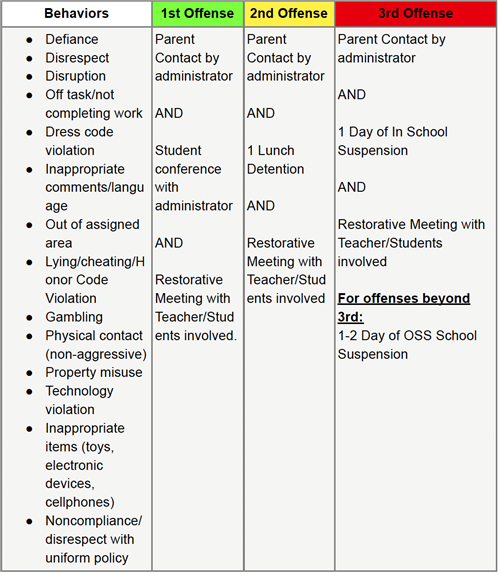

**After School Detention can be given as a consequence at the discretion of Administration. If After School Detention cannot be served - student will serve 1/2 day of In School Suspension.
Level 2
Level 2 Behaviors: These are behaviors that are major office referrals that are considered lower level major incidents. These behaviors will be handled by an administrator, but may be able to wait (not immediate).
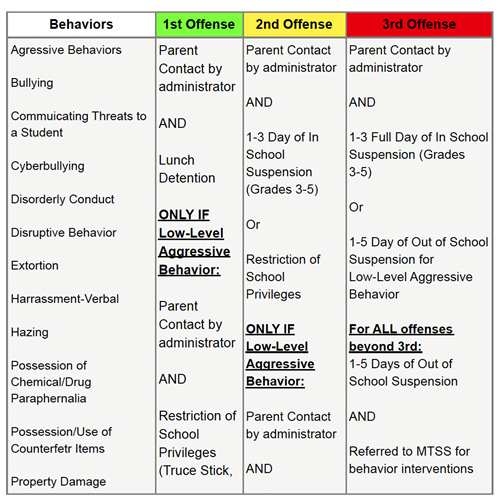
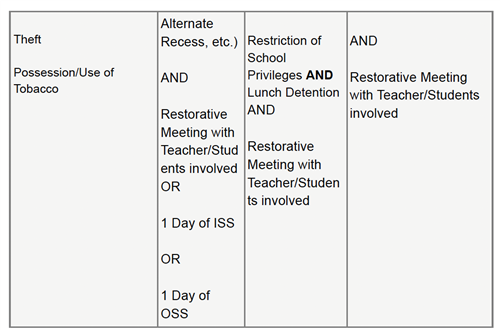
Level 3:
Level 3 Behaviors: These are behaviors that are major office referrals that are considered higher level major incidents. These behaviors will be handled by an administrator immediately.
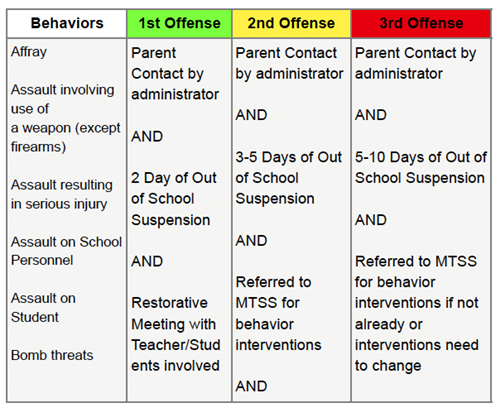
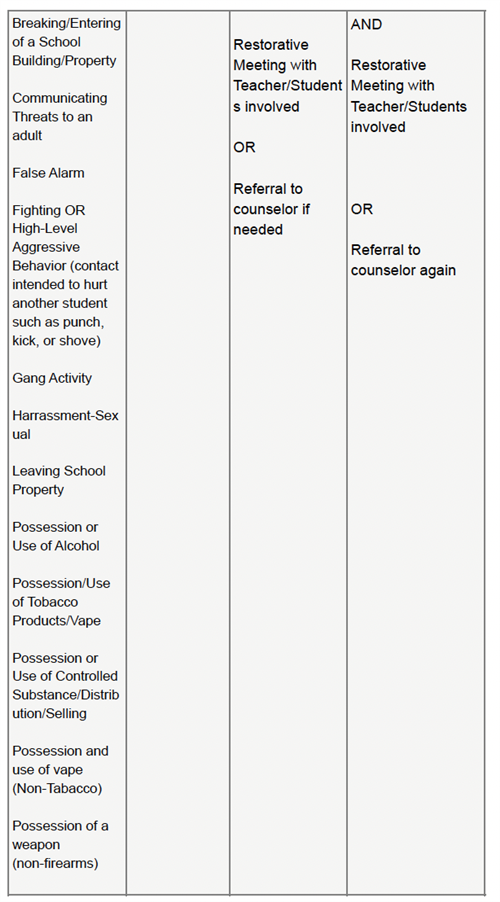
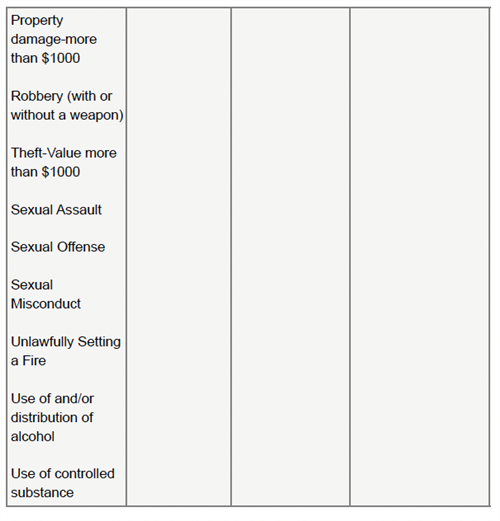
Level 4:
Level 4 Behaviors: These are behaviors that are major office referrals that are considered the highest level major incidents. These behaviors will be handled by an administrator immediately.
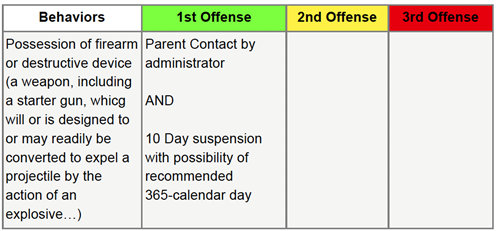

-
CLASSROOM BEHAVIOR INTERVENTIONS
